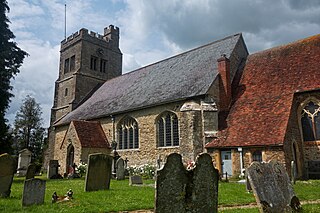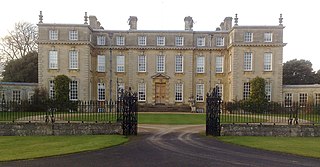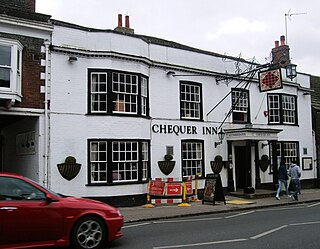
A pub is in several countries a drinking establishment licensed to serve alcoholic drinks for consumption on the premises. The term first appeared in England in the late 17th century, to differentiate private houses from those open to the public as alehouses, taverns and inns. Today, there is no strict definition, but CAMRA states a pub has four characteristics:
- is open to the public without membership or residency
- serves draught beer or cider without requiring food be consumed
- has at least one indoor area not laid out for meals
- allows drinks to be bought at a bar

The Angel, Islington, is a historic landmark and a series of buildings that have stood on the corner of Islington High Street and Pentonville Road in Islington, London, England. The land originally belonged to the Clerkenwell Priory and has had various properties built on it since the 16th century. An inn on the site was called the "Angel Inn" by 1614, and the crossing became generally known as "the Angel". The site was bisected by the New Road, which opened in 1756, and properties on the site have been rebuilt several times up to the 20th century. The corner site gave its name to Angel tube station, opened in 1901, and the surrounding Angel area of London.

Pub names are used to identify and differentiate traditional drinking establishments. Many pubs are centuries old, and were named at a time when most of their customers were illiterate, but could recognise pub signs. The use of signage was not confined to drinking establishments. British pubs may be named after and depict anything from everyday objects, to sovereigns, aristocrats and landowners. Other names come from historic events, livery companies, occupations, sports, and craftsmen's guilds. One of the most common pub names is the Red Lion. This list contains both modern and historical examples.

Westbere is a small village and civil parish in Kent, England, centred 4 miles (6.4 km) north-east of Canterbury city centre along the A28 road to the Isle of Thanet.

Barkston Ash is a small village and civil parish close to Selby in North Yorkshire, England. It was formerly known as Barkston, in the West Riding of Yorkshire. In 2011 the parish had a population of 370.

The Spaniards Inn is a historic pub on Spaniards Road between Hampstead and Highgate in London, England. It lies on the edge of Hampstead Heath near Kenwood House. It is a Grade II listed building, dating back to the 16th century.

Smarden is a civil parish and village, west of Ashford in Kent, South East England.

Ditcheat is a village and civil parish 4.5 miles (7 km) south of Shepton Mallet, and 2.5 miles (4 km) north-west of Castle Cary, in Somerset, England. Besides the village, the parish has four hamlets: Wraxall, Lower Wraxall, Alhampton and Sutton.

Ditchley Park is a country house near Charlbury in Oxfordshire, England. The estate was once the site of a Roman villa. Later it became a royal hunting ground, and then the property of Sir Henry Lee of Ditchley. The 2nd Earl of Lichfield built the present house, designed by James Gibbs, in 1722. In 1933, the house was bought by an MP, Ronald Tree, whose wife Nancy Lancaster redecorated it in partnership with Sibyl Colefax. During the Second World War Winston Churchill used the house as a weekend retreat, due to concerns that his official country house, Chequers and his private country home, Chartwell, were vulnerable to enemy attack. After the war, Tree sold the house and estate to the 7th Earl of Wilton, who then sold it in 1953 to Sir David Wills of the Wills tobacco family. Wills established the Ditchley Foundation for the promotion of international relations and subsequently donated the house to the governing trust.

Stoke Row is a village and civil parish in the Chiltern Hills, about 5 miles (8 km) west of Henley-on-Thames in South Oxfordshire and about 9 miles (14 km) north of Reading. The 2011 Census recorded the parish population as 651.

Over Kiddington is a hamlet in the civil parish of Kiddington with Asterleigh in Oxfordshire, England, about 7 miles (11 km) southeast of Chipping Norton. Over Kiddington is on the main road between Woodstock and Chipping Norton, which since the 1990s has been classified as part of the A44 trunk road. The hamlet is at the crossroads where the minor road to Kiddington village and Ditchley Park house crosses the main road. The crossroads is overhung by a large cedar tree that is a notable landmark.

The Ram Jam Inn was a historic pub in the civil parish of Greetham, Rutland, England, located on the west side of the Great North Road, near Stretton, about 7 miles north of Stamford. It was frequented by the highwayman Dick Turpin in the 18th century, and it is claimed that one of his confidence tricks inspired the pub's name. The pub closed in 2013, and plans to demolish it were put on hold: it was finally demolished in the early 2020s.

The Chequer Inn is a historic 15th Century coaching house in the Conservation Area of the old market town of Steyning, in the Horsham District of West Sussex, United Kingdom. English Heritage has listed the building at Grade II for its architectural and historical importance.

The Flask is a Grade II listed public house at 74–76 Highgate West Hill, Highgate, London. According to the 1936 Survey of London, a pub known as The Flask has stood on this spot since "at least as early as 1663". The present buildings probably date from the early 18th century, and were partially rebuilt in about 1767 by William Carpenter. A Manorial court met there in the eighteenth century. The Flask is currently owned and operated by the London-based Fuller's.

The Bell Inn is a pub at the village of Aldworth, in the English county of West Berkshire. It won CAMRA's National Pub of the Year in 1990, and received the accolade again for 2019. It is a Grade II listed building and is the only pub in Berkshire with a Grade II listed interior. It is also on the Campaign for Real Ale's National Inventory of Historic Pub Interiors.

The Bridge Inn is a Grade II listed public house at Bridge Hill, Topsham in the county of Devon, England. Mentioned as a dwelling in Domesday Book, the building was largely constructed in the 18th century of cob and stone, with a 19th-century brick addition. Queen Elizabeth II visited the inn on 27 March 1998, her first official visit to a pub.

The Chequers was a public house which occupied a Grade II listed building in Potters Bar, England. Originally opening in the 1700s, the pub moved site across the road and opened in its current location in the 1840s. Although there is no consensus as to when the current building was originally constructed, it started as two separate houses which were joined together before the pub moved onto the site.

The Green Man is a pub and road junction on High Road, Leytonstone, London. The pub has been rebranded as part of the O'Neill's chain. The current 1920s building replaced an earlier public house, close to the original site; which was built around 1668 and mentioned by Daniel Defoe.

The Red Lion is a pub in the city centre of York, in England.



















